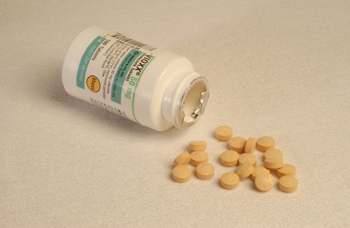
VUMC researchers have found that doctors continue to prescribe Vioxx at high doses for a long time, even though it raises the risk for serious heart problems. Photo by Anne Rayner
New device helps patients get back on their feet
A new device at Vanderbilt Stallworth Rehabilitation Center is helping patients make great strides towards walking again. Created by HealthSouth, the AutoAmbulator is designed to help rehabilitate patients who have gait disorders and other ambulation impairments.
After using the AutoAmbulator only three times, Stallworth patient Donald Moore said he could see clear-cut results.
“I’ve seen a lot of improvements — I’m able to walk further. And at first I couldn’t bend my toes up, but now they’re bending and it’s working. I can walk better now,” he said.
Moore, who was diagnosed with multiple sclerosis in 2000, is recovering from an exacerbation which weakened his legs. Prior to using the machine, Moore could only walk 10 feet with a walker. After three sessions, he is walking more than 150 feet with a walker, and his gait has tremendously improved, according to his physical therapist.
“I think just in the past few weeks we have already seen improvements in our patients’ endurance. Cardiovascularly they are doing better. They are able to walk farther, and they’re able to do it faster. Their balance is better, and I think most importantly, their gait patterns are better,” said Kristen Keeney, a physical therapist at Stallworth.
“We can talk about the clinical implications all day long, but I think it’s really important to stress how our patients are responding — and I think that’s in their quality of life. They’re going from walkers to canes, and sometimes from canes to nothing. I think they have more confidence and are more motivated,” she said.
The AutoAmbulator is a sophisticated treadmill device that allows patients with conditions that limit walking and balance to replicate normal walking patterns. It holds a patient upright while robotic braces move the patient’s legs across the treadmill. The machine is powered through its integrated computer system, and sensors track numerous functions, continuously monitoring and adjusting power and speed according to each patient’s physical requirement.
Robertson Coxe, M.D., medical director of Vanderbilt Stallworth Rehabilitation Hospital, said the design of the machine helps patients focus on gait and advance gait more quickly than they could with previous methods. This is important for many reasons, he said.
“Ambulation is such a key goal for patients across the board in rehab. They may have deficits that are far-reaching and many have multiple deficits, but in general, ambulation is at the top of the priority list for most people. So unless they make gains in transfers and ambulation, many patients feel like they aren’t getting better.
“Rehab is such a goal-driven process and patients set variable levels of goals. This is a key part of their rehab, and self-efficacy is such a key part of setting goals. So when patients are confident, it impacts them in a lot of ways — and success is one of those ways,” Coxe said.
HealthSouth began developing the AutoAmbulator five years ago. Gary West, the director of engineering for the project, said the project started after he was contacted by a HealthSouth executive who had seen a quadriplegic on a crude device.
“He just had the idea that there’s got to be a better way to do this,” West said. “So we started with a sketch on the chalkboard, and this is five years later — we’ve made some pretty significant advances.”
The FDA granted HealthSouth permission to begin using the AutoAmbulator with patients in 2002. According to West, the project has been one of his most gratifying.
“You like to take pride in what you do, but something like this — you can see that it’s helping people. It’s an unbelievable feeling.”
Joel Gordon, interim chairman of HealthSouth, said the company’s partnership with Vanderbilt — the Stallworth Rehabilitation Center — is one of the prime examples of what he thinks HealthSouth is all about.
“We like to be able to develop, in conjunction with our partners, something that brightens patient care and helps improve the lifestyles of people with physical disabilities,” Gordon said. “I think the AutoAmbulator will dramatically increase the patient treatment capabilities of Stallworth, and hopefully it will dramatically improve people’s lifestyles.”
Harry R. Jacobson, M.D., vice chancellor for Health Affairs, said the ability to offer this new device is the product of a successful relationship with HealthSouth, and is something that makes Vanderbilt a unique health care provider.
“Vanderbilt is the only complete, full-service health care provider in this region, and this hospital [Stallworth] is one of the main reasons that we can say that. When you think about the continuum of care for patients, it’s not just the acute episodes or the acute problems they have — we need to bring people back to as functional as they can be after they have a problem,” Jacobson said. “This hospital really enables us, as well as the whole community, to do that.”
For patients like Moore, the success they see with the AutoAmbulator improves their hope for becoming fully functional again. Though Moore has only been on the device a few times, he’s looking forward to seeing just how fast it can go.
“I hope I’ll be able to run again when I’m done with it,” he said.













